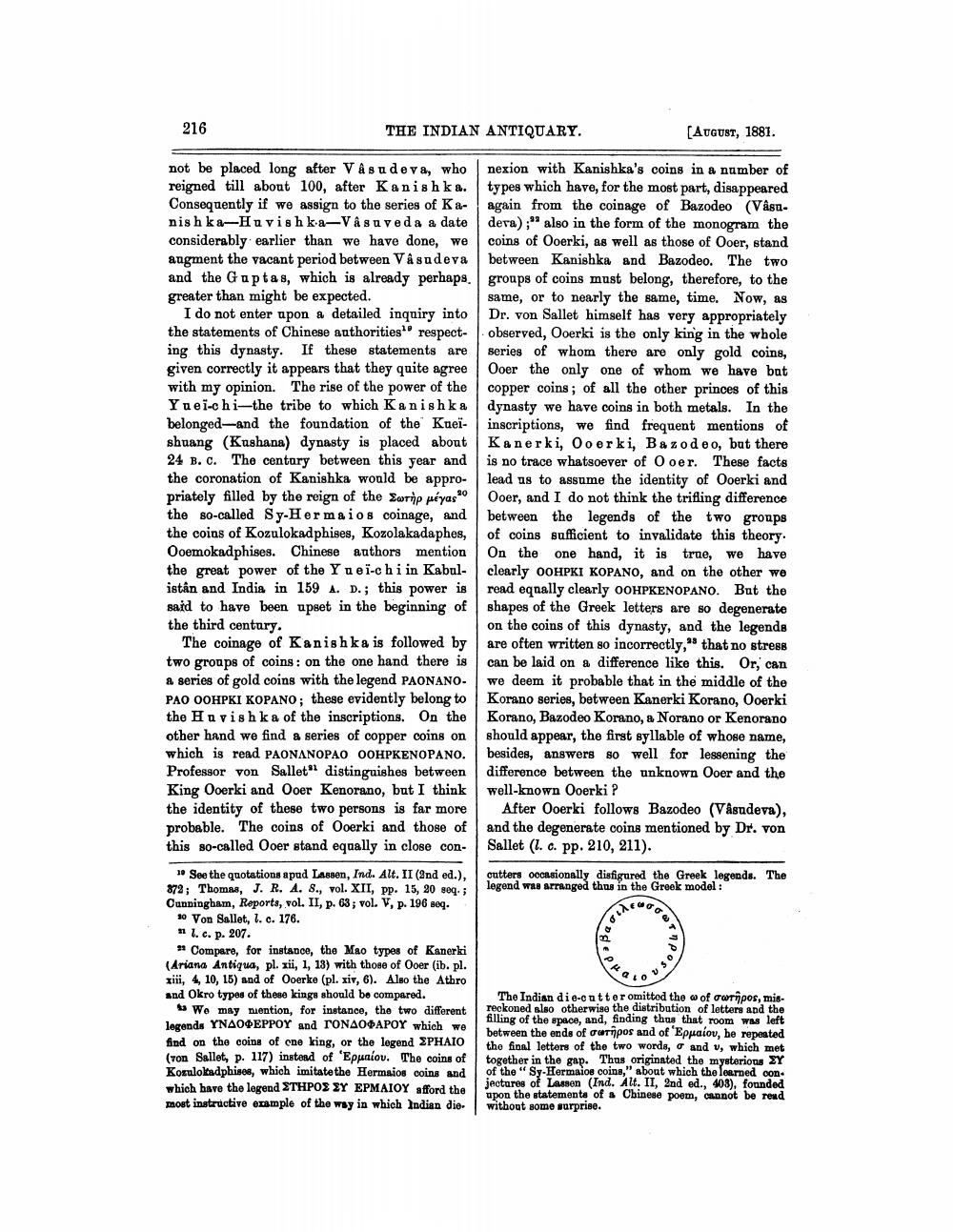________________
216
THE INDIAN ANTIQUARY.
(AUGUST, 1881.
not be placed long after Vasudeva, who nexion with Kanishka's coins in a number of reigned till about 100, after Kanishka. types which have, for the most part, disappeared Consequently if we assign to the series of Ka- again from the coinage of Bazodeo (Vågu nish ka-Huvish ka–V â su veda a date deva);" also in the form of the monogram the considerably earlier than we have done, we coins of Ooerki, as well as those of Ooer, stand augment the vacant period between Vasudeva between Kanishka and Bazodeo. The two and the Guptas, which is already perhaps. groups of coins must belong, therefore, to the greater than might be expected.
same, or to nearly the same, time. Now, as I do not enter upon a detailed inquiry into Dr. von Sallet himself has very appropriately the statements of Chinese authorities respect-| observed, Ooerki is the only king in the whole ing this dynasty. If these statements are series of whom there are only gold coins, given correctly it appears that they quite agree Ooer the only one of whom we have bat with my opinion. The rise of the power of the copper coins; of all the other princes of this Yu ei-chi-the tribe to which Kanishka dynasty we have coins in both metals. In the belonged-and the foundation of the Kuei- inscriptions, we find frequent mentions of shuang (Kushana) dynasty is placed about Kanerki, Ooerki, Bazod eo, but there 24 B. C. The centary between this year and is no trace whatsoever of Ooer. These facts the coronation of Kanishka would be appro- lead us to assume the identity of Ooerki and priately filled by the reign of the Earne péyasa Ooer, and I do not think the trifling difference the so-called Sy-Hermaios coinage, and between the legends of the two groups the coins of Kozulokadphises, Kozolakadaphes, of coins sufficient to invalidate this theory. Ooemokadphises. Chinese authors mention On the one hand, it is true, we have the great power of the Y u ei-chi in Kabul- clearly OOHPKI KOPANO, and on the other we istan and India in 159 A. D.; this power is read eqnally clearly OOHPKENOPANO. But the said to have been upset in the beginning of shapes of the Greek letters are so degenerate the third century.
on the coins of this dynasty, and the legende The coinage of Kanishka is followed by are often written so incorrectly," that no stress two groups of coins : on the one hand there is can be laid on a difference like this. Or, can a series of gold coins with the legend PAONANO. we deem it probable that in the middle of the PAO OOHPKI KOPANO; these evidently belong to Korano series, between Kanerki Korano, Ooerki the Havish ka of the inscriptions. On the Korano, Bazodeo Korano, a Norano or Kenorano other hand we find a series of copper coins on should appear, the first syllable of whose name, which is read PAONANOPAO OOHPKENOPANO. besides, answers so well for lessening the Professor von Sallet" distinguishes between difference between the unknown Ooer and the King Ooerki and Ooer Kenorano, but I think well-known Ooerki ? the identity of these two persons is far more 1 After Ooerki follows Bazodeo (Vasudeva), probable. The coins of Ooerki and those of and the degenerate coins mentioned by Dr. von this so-called Ooer stand equally in close con- Sallet (l. c. pp. 210, 211).
cutters occasionally disfigured the Greek legends. The legend was arranged thus in the Greek model:
** See the quotations apud Lassen, Ind. Alt. II (2nd ed.), 872; Thomas, J. R. A. 8., vol. XII, pp. 15, 20 seq. ; Cunningham, Reports, vol. II, p. 63; vol. V, p. 196 seq.
30 Von Sallet, l. c. 176. 1 1. c. p. 207.
* Compare, for instance, the Mao types of Kanerki (Ariana Antiqua, pl. xii, 1, 13) with those of Ooer (ib. pl. xiii, 4, 10, 15) and of Ooerke (pl. xiv, 6). Also the Atbro and Okro types of these kings should be compared.
We may nuention, for instance, the two different legends YNAOPEPPOY and TONAOWAPOY which we find on the coins of cne king, or the legend EPHAIO (von Sallet, p. 117) instead of Epou. The coins of Kozulokadphises, which imitate the Hermaios coins and which have the legend ΣΤΗΡΟΣ ΣΥ ΕΡΜΑΙΟΥ afford the I
tud most instructive example of the way in which Indian dio
The Indian die-cattor omitted the w of carnpos, mis
blling of the space, and the distribution of letteripos, mis.
filling of the space, and, finding thus that room was left between the ends of ourñpos and of Eppalov, he repeated the final letters of the two words, and v, which met together in the gap. Thus originated the mysterious SY of the "Sy-Hermaioe coins,"..about which the learned con jectares of Lassen (Ind. Alt. II, 2nd ed., 408), founded upon the statements of a Chinese poem, cannot be rend without some surprise.




